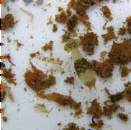Basic HTML Version


Summer:
l o o k i n g a f t e r y o u r
w i l d l i f e p o n d
p
o
n
d
v
i
s
i
t
o
r
s
Dragonfly larvae
As
young frogs, toads and newts
make their first tentative steps onto
land, summer ponds are full of all sorts
of other emerging life.
Dragonfly and
damselfly larvae
can be seen climbing
out of ponds before turning into majestic
flying adults.
Water boatmen
flourish
and
pond snails
hatch out in droves to
hoover up the pond algae. Like spring,
it’s a great time of year for torching. Be
wary of stone slabs near the pond at
this time of year - in hot, sunny weather
emerging amphibians can quickly dry out
and die on hot paving slabs. You can stop
this happening by covering these areas
temporarily with a damp towel, or a moist
lawn roll or by adding logs and plants to
the edge of the pond (see page 26).
Problem plants can be a continuing issue
in the summer months, and in many
years some of the
pond plants
may need
cutting back. Be mindful of causing too
much havoc at this time of year - many
invertebrates are particularly sensitive to
disturbance.
When
cutting the lawn
or
strimming
lawn edges
be especially careful of
disturbing frogs, particularly young ones.
Long grass
is a favourite summer haunt
and many injuries occur to amphibians by
mowers and strimmers during this time.
You can limit the damage by walking the
garden length thoroughly before mowing.
Most frogs will hop away once disturbed.
Consider leaving parts of the lawn to grow
wild and ensure mown areas are kept
short throughout.
In some parts of the UK, you might
come across lots of dead or dying frogs
throughout the warmer months. If this is
the case please contact Froglife and help
our research on amphibian diseases
(www.froglife.org/disease).
Summer is also a likely time to see
grass snakes
make hunting forays into
gardens, particularly in areas where there
are lots of amphibians. Grass snakes are
the ultimate compliment to your wildlife
gardening.

